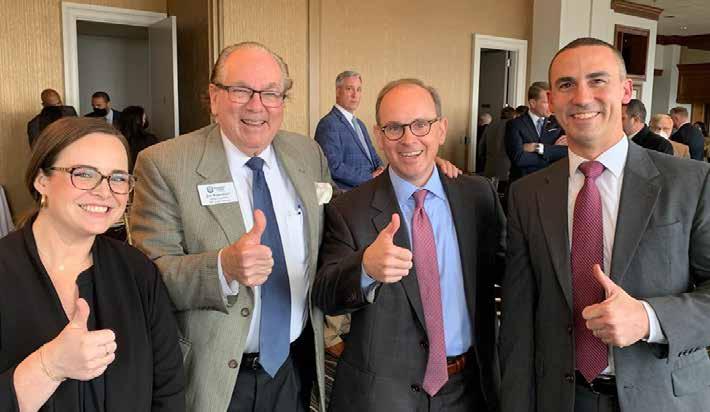political interference, animosity towards the poor, and pervasive racial prejudice; and despite the ever-present problem of inadequate funding. The first people to head public defender offices were on quixotic quests, and too often, in jousting with their controlling boards, found themselves defeated. Mayeux examines what it means to be a public defender organization. Public defenders could have been agents of legal and even social change, a reform movement, or at least a check on government power. The organizations could have been a way for “imagining the proper balance of power in a modern society between lawyers, the individual, and the state.” But nearly all the organizations were narrowly confined to criminal representation, usually in one jurisdiction, with a constant struggle for funding. Adversaries in court, public defenders found themselves also pitted against the police and prosecutors in legislative budget fights. We know who wins. Mayeux ends her study just as harsh mandatory minimum sentences and the War on Drugs impacted the criminal justice system and strained public defense even more. The lack of adequate funding warped court decisions. Scholars, most notably the late William Stuntz, decried this fact because it precludes effective representation and leads to a skewing of criminal justice and procedure. Mayeux points to hopeful exceptions. Small nonprofit organizations that take a holistic approach have sprung up. They represent indigent defendants, but they also deal with their clients’ substance abuse, mental illness, housing needs, domestic matters, and employment. They seek to fulfill the reformers’ promise. They work. We still live with the consequences. As praiseworthy as these models are, it is hard to envision them as other than small nonprofits. Public defender organizations as they presently exist struggle to deal with just the criminal caseload and are not capable of providing indigent services. It would be too daunting to reconstruct local, state, and federal indigent defense as they presently exist. They require radical rethinking and funding. Public defenders meanwhile seek to remedy many of the harsh and punitive policies of the past half century. In this way, public defender organizations can lead the way “to unwind mass incarceration, promote racial justice, alleviate economic inequality, challenge draconian immigration enforcement, and serve as the vanguard of a twenty-first
century civil rights movement.” These public defenders can join with progressive prosecutors to change how we treat indigent defendants and can advocate for legislation. This means bringing back the ideals of social reform that initially animated the movement to provide indigent defense. Still, the path is hard. The federal experience is cautionary. A recent report on the federal defender system, the Cardone Report, set forth principles for indigent representation, the most important being independence for the system. Though it was released with much fanfare, the judiciary considered many of the recommendations too radical. Congress has scant interest. Alas, the report is honored more in principle than in practice. Mayeux would understand. Jon M. Sands is the federal public defender for the District of Arizona.
The Original Meaning of the 14th Amendment: Its Letter and Spirit By Randy E. Barnett and Evan D. Bernick Harvard University Press, 2021 465 pages; $35.00
Reviewed by Henry S. Cohn
Professors Randy Barnett and Evan Bernick, both of Georgetown University Law Center, have two purposes in writing The Original Meaning of the 14th Amendment:
Its Letter and Spirit. The first is to find “the original public meaning of the text” of the Fourteenth Amendment. In his forward to the book, leading Civil War historian James Oakes finds the authors’ efforts with respect to this purpose “superb.” He is impressed by the authors’ efforts to explain where phrases in the Fourteenth Amendment originated, what they meant when the Fourteenth Amendment was adopted by Congress in 1866, and how their meaning has changed over time. Having examined the original meaning of the Fourteenth Amendment, the authors’ second purpose is to apply the original meaning to various Supreme Court cases that interpret the Fourteenth Amendment. They do so because they follow the originalist approach to interpreting the U.S. Constitution. This approach has been defined as respecting, and adopting as final, the original meaning of phrases in the Constitution, at least where this meaning is specifically discernable. According to originalists, this meaning alone is to be used to decide constitutional cases. Originalism is highly controversial and has been rejected by other academics. Indeed, a 2009 New York University Law Review article by Mitchell N. Berman is titled “Originalism is Bunk.” The book’s finest moments are in its discussion of three clauses in section 1 of the Fourteenth Amendment: the Privileges and Immunities Clause, the Due Process Clause, and the Equal Protection Clause. The authors’ most dramatic conclusion is that, although before the Civil War, the abolitionists were a disliked minority, their ideas had the most impact on the Fourteenth Amendment. Congressman John Bingham drafted the amendment, and abolitionism, according to Bingham’s biographer Gerard Magliocca, “was his life’s pursuit.” The authors spend several chapters on the phrase in section 1 that declares, “No State shall make or enforce any law which shall abridge the privileges or immunities of citizens of the United States.” The phrase comes from Sir William Blackstone’s Commentaries on the Law of England, published in the 1770s. Blackstone’s volumes were a major source for legal education in 18th-century America. Thomas Jefferson, following Blackstone and Lord Mansfield (whose 1772 decision in Somerset v. Stewart declared that American slaves became free when they were brought to England), used the concept of privileg-
March/April 2022 • THE FEDERAL LAWYER • 69










